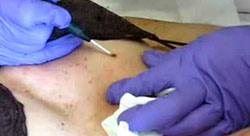Benign moles are skin blemishes that are non-cancerous that don’t pose any risk to your health. Since they are not dangerous, some folks wonder why they’d even need to get them removed. There are several reasons why people turn to benign mole removal. Most of them are for cosmetic purposes to enhance physical appearance. Countless numbers of people have gone through social rejection because they have a noticeable and unsightly mole on their face or neck. In other cases, even though the mole is benign, it might cause frequent itching if on the waistline or somewhere that clothes irritate it.

Different Benign Mole Removal Procedures
There are basically three different mole removal procedures that can be used to get rid of a benign mole. The first two are considered surgical since they involve cutting the skin. The first removal procedure is known as excision. Typically, the physician cuts the mole off of the skin after local anesthesia. Sometimes they might use a special scalpel to shave off the top of the mole to apply medicine. Often surgery requires incisions that are stitched up. Stitches can be dissolvable or they might be traditional stitches that the physician will remove days later. The second procedure involves cutting as well, but in addition, a tool is used to burn the mole. The last mole removal procedure is the laser treatment. With this procedure you might see less scarring but it’s not effective on larger moles. Lasers can’t penetrate deep into the skin.
Possible Risks
Even though benign mole removal can be done quickly at the doctor’s office, there are a few risks that you should be aware of before making the decision to have it done. Since mole removals involve cutting, the physician will apply local anesthesia on the area where the mole is going to be cut off. That’s where the first risk appears. If you are allergic to any anesthesia, you must communicate this to your doctor in order to find an alternative way of dealing with the removal. The second risk involves infection. It’s beyond easy for an open wound to get infected if it’s not cared for properly. Be sure to respond appropriately to your wound in order to avoid all types of infection. The final common risk is heavy bleeding. Even though the open wound is expected to bleed a little, if you notice a lot of bleeding, contact your physician or visit the hospital immediately.
Importance of Proper Healing
Even though scarring is inevitable after a mole removal procedure, taking proper care of the wound will increase your chances of it going unnoticeable. After the procedure, you will be left with a cut that has been stitched up and needs to be healed. If you allow the healing process to take its course without complications, then you should be completely recovered within a matter of days. For proper healing, just make sure to keep the area clean at all times and don’t be overexposed to the sun!
